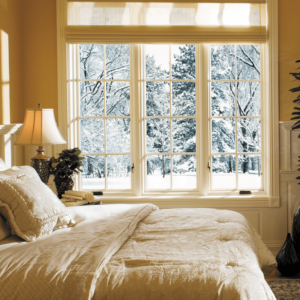Prep for the Polar Vortex — Insulating Your Windows for Winter
Apr 01, 2024
Simple Tips to Keep Heat In, Cold Out
Like getting out of your comfort zone? Good! Winter’s coming. Prep for the polar vortex. While I enjoy a cool breeze on my face as much as the next guy, I don’t like it when the cool breeze is in my living room, coming from a draft. And I don’t like opening energy bills that cause me to say words loudly.
But insulation can help. Insulation is any material used to slow or stop the transfer of energy—whether heat, electricity, or sound—between spaces. Nature’s laws say the heat will always flow from warmer to colder spaces. In your house, that looks like warmth leaking out your roof, walls, or windows in the winter, and as sun battling your air conditioner for control of the indoor temperature in summer. Both can make your energy bills soar.
Fall is an excellent time to evaluate and improve your home’s insulation. While the ancient Greeks and Romans didn’t get energy bills, they still understood that insulation increases the comfort of home. They used natural materials such as stone and cork in their houses, while our pioneers relied on mud, straw, or wood shavings. Depending on its age, your home probably employs some form of natural fiber (such as cellulose) or synthetic fill (such as fiberglass, foam board, or mineral wool) to manage temperature extremes.
Windows, however, are another story. Although glass is relatively inert with poor thermal conductivity, heat still escapes faster per square foot of glass than through any other surface in the home, such as floors, walls, roofs, etc.
So what can you do to keep heat indoors in the months ahead? Here are some choices for insulating your windows.
DIY Options with Caulk and Window Film
 Start with the obvious stuff—gaps or cracks in the frames around your windows. Caulk works well here, and it comes in different forms. Rope caulk is actually a super-long string of putty that you unwind and press into cracks with your fingers. Latex or silicone-based caulk comes in tubes requiring a caulk gun to install. While trickier to apply, it’s the longer-lasting solution.
Start with the obvious stuff—gaps or cracks in the frames around your windows. Caulk works well here, and it comes in different forms. Rope caulk is actually a super-long string of putty that you unwind and press into cracks with your fingers. Latex or silicone-based caulk comes in tubes requiring a caulk gun to install. While trickier to apply, it’s the longer-lasting solution.
Then there are the windows themselves. If you don’t mind losing your view (say, in the basement or attic), consider sticking bubble wrap to the inside of your window. Spray a thin layer of water on a clean window and push the bubble wrap into place. Then secure the edges with painter’s tape so you don’t mar the finish when removing the wrap in spring.
Plastic window films work the same way, but without impairing your view. Many home improvement and hardware stores sell kits containing double-sided sticky tape and plastic film pre-cut to standard window sizes. On the inside of your home, apply the sticky tape to the window frame; then press the plastic film into place. Heat the film with a blow dryer to shrink it and form a tight seal.
Another option is reflective—or low-emissivity (“low E”)—window film. Again, apply this product directly to the interior window surface. Instead of forming an air pocket, though, low-E window film blocks thermal energy from crossing a reflective surface on the film. This holds in heat during winter and reflects the sun away from your windows in summer, reducing solar gain.
 Are Replacement Windows for You?
Are Replacement Windows for You?
The most permanent solution, of course, is replacing old, leaky windows with new, energy-efficient ones. If you’re considering this route, here are three factors to weigh.
Window frames. The material surrounding your window contributes to its overall energy efficiency. At one end of the continuum are metal frames, like aluminum, which conduct heat rapidly. This makes them poor choices as far as insulation. In the middle of the continuum are frames made of synthetic materials such as fiberglass or vinyl. Not only are these materials less conductive; they may also come with air cavities or hollows that can be filled with insulation. Best from an insulation standpoint, though, are wooden frames, as long as they aren’t clad in metal, since wood is poor at conducting heat.
Window glazing. Windows today often come with more than one layer of glass, precisely because of the energy efficiencies involved. Double-glazed windows incorporate two panes of glass in the frame, while triple-glazed windows have (you guessed it) three panes. It’s not uncommon for inert gases to be sandwiched between panes for greater insulating properties. (See below.)
Insulating gases between glass layers. Inert gases are substances such as argon or krypton that are chemically non-reactive. Because they are non-reactive, sealing these gases inside double-and triple-paned windows minimizes heat transfer and increases insulation properties. While more expensive, these gas-filled windows also have the best insulating properties.

How Can We Help You Prep for the Polar Vortex?
At McCann Windows & Exteriors, we want you snug as a bug in a rug all winter. Let us help you figure that out by evaluating the fit and energy efficiency of your home’s windows and doors. We’re ready to serve you and estimates are free! Please just give us a call at (847) 892-4071 or fill out our schedule form here. We’ll be right over.
Warmly yours,
Kevin McCann
1 “Insulation,” Merriam-Webster online dictionary: https://www.merriam-webster.com/dictionary/insulation.
2 Mike O’Hara, “The Story of Insulation: A Tale to Warm More Than Your Heart,” accessed Sept. 15, 2019: https://www.insulatekansascity.com/insulation-blog/story-insulation-tale-warm-heart/
3 “Types of Insulation,” Department of Energy, accessed Sept. 15, 2019: https://www.energy.gov/energysaver/weatherize/insulation/types-insulation.
4 Sarma Pisupati, “Windows and Heat Loss,” EGEE 102: Energy Conservation and Environmental Protection, Penn State College of Earth and Mineral Sciences, accessed Sept. 16, 2019: https://www.e-education.psu.edu/egee102/node/2017.
5 Dwayne Hogan, “5 Ways to Insulate Your Apartment Windows for Winter,” Move.org, updated Dec. 18, 2015: https://www.move.org/5-ways-insulate-apartment-windows-winter/
6 Ibid.
7 Lee Wallender, “How to Insulate Windows,” The Spruce, updated Feb. 8, 2019: https://www.thespruce.com/how-to-insulate-windows-4159324
8 Hogan, “5 Ways to Insulate Your Apartment Windows for Winter”: https://www.move.org/5-ways-insulate-apartment-windows-winter/
9 “Window Types and Technologies,” Department of Energy, accessed Sept. 16, 2019: https://www.energy.gov/energysaver/window-types-and-technologies
1o “Window Types and Technologies,” https://www.energy.gov/energysaver/window-types-and-technologies
11 Ibid.











